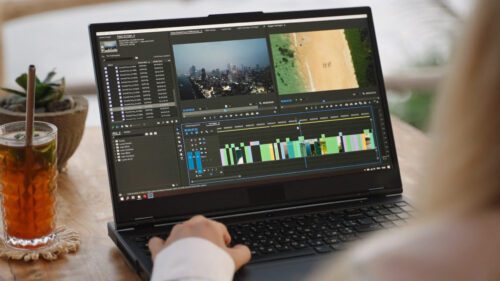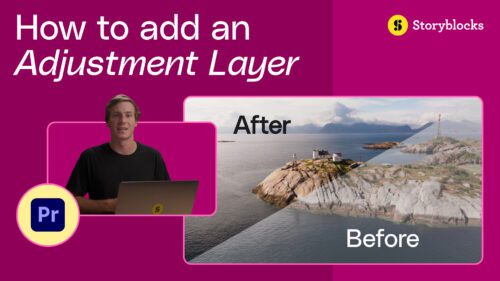To excel as a motion graphics designer, you need advanced composition skills, and masks are the most important tool in this field. Masks are a fundamental After Effects tool to get you going and you must learn this skill to advance your career and keep up with the pros.
An otherwise uninteresting scene can gain extra appeal by adding an engaging animation behind an object. All you have to do to get this stunning effect is mask the object from your composition and add graphics or text behind it.
Of course, you must first master the fundamentals before getting your sea wheels on. This article provides a comprehensive After Effects tutorial for the masking effect to get you started.
What is an After Effects Masking Effect?
Masks can be a path or outline used to modify layer effects and attributes. In After Effect, a mask is often a shape that reveals or conceals a particular region of a layer in your composition.
You can use masking to hide or reveal a portion of a layer or an object. An item, such as text, may first be covered by a mask in an animation before the mask slides out to reveal the object. Alternatively, you can have them stay still in the picture and crop out unwanted features.
Additionally, masking is essential in the motion picture industry since, occasionally, you may need to take anything out of the video after the shoot. In these situations, masking is perhaps the best solution. Plus, you could clip out objects from pictures or videos, draw shapes, or even add a design of your choice to your favorite music videos.
What Are The Different Ways To Mask?
You can deploy the masking effect in two ways:
- Using the Pen Tool
- Using the Shape Tool
Let’s break them down:
Using the Pen Tool
You may often have to draw something more organic, and that’s where the Pen tool comes in. The most accurate method of masking a picture is with the pen tool. It can be used for intricate masking tasks and lets you design any shape you choose.
Make sure to construct a closed route, also known as a mask, while using the pen tool to build the masks. The pen tool is used to create a complete “shape” of a closed bath. It won’t be possible for you to make a mask if you leave an open path.
You can easily design your mask by selecting the pen tool or using the “G” key on your keyboard. To produce shapes with rounded corners, click and drag your selected points. Several variant Pen tools are on the menu to add, remove, and change these path points. You can cycle through these variant settings by repeatedly pressing G.
Using the Shape Tool
You can create masks using the shape tool in simple shapes like circles, triangles, and squares. You can mask off a portion of the frame by selecting the mask tool, clicking on any shape, or navigating between the shapes using the “Q” key on your keyboard.
After you’ve chosen a shape, click and drag your mouse on the image. It will automatically create the shape for you in the direction you’re dragging it from.
On a Mac, you can create the shape by pressing control or command, and the shape will be created from the center rather than from the sides.
If you press and hold shift while creating the shape, all its sides will be drawn the same size.
Types of Masks
There are two types of masks; regular and shape layer masks. When you select your layer on your timeline you will create a regular mask. A shape layer mask is created when you don’t.
How to Create a Regular Mask
You can create a regular mask by:
- Choosing your image/video on your timeline
- Selecting the shape tool icon on the top toolbar
- Drawing your rectangle mask on your image/video
How to Create a Shape Layer Mask
You can create a shape layer mask through this process:
- Make sure no layer is selected on your timeline.
- Click the Shape Tool icon on the top toolbar.
- Select the rectangle tool to draw a rectangle.
- Ensure your rectangle shape layer is above the image/video layer.
- Select your image/video layer and change track matte to Alpha.
How to Animate Masks
Masks don’t always have to be static items that hide or reveal certain elements in a frame. They can be animated in After Effects the same way as other elements to provide stylish, smooth transitions and revelations. To animate a mask:
Step 1: Choose the mask you wish to animate in the layer it is sitting in.
Step 2: Collapse the drop-down and select stopwatch next to the Mask Path. This will generate a keyframe and the starting point of the mask.
Step 3: Move the playhead in time.
Step 4: Position the mask in the desired manner.
Step 5: Press the stopwatch once again. The mask will then transition from its initial position to its final position in the time you specified for the playhead to move.
You can keep adding keyframes to the mask path to slow down, speed up, smooth out the animation, and generally move the mask in various ways. To create a keyframe, drag the playhead to the time you want the current animation stage to end, adjust the mask’s size or position, and then click the stopwatch again.
Examples of After Effects Masking
Some examples of After Effects masking include:
Curved Masking
When you create masks using the Pen Tool, you create masks using straight lines. However, this type of masking involves creating masks with curved lines using Bezier curves.
Feathered-Edge Masking
Feathered -Edge masking involves softening the edges of a mask and can be done by pressing F on your keyboard, selecting the Mask Feather property, and dragging the yellow values to adjust the edges.
Inverted Masking
Inverted masking involves masking out everything except what is inside the mask and reversing it so that everything shows except what is inside the mask.

Utilize Storyblocks Templates for Easy Video Content Creation
There you go! With this guide, you are well on your way to creating that stunning graphic. Storyblocks is here to make your journey easier. Unlock access to our library of over a million royalty-free footage, music, Adobe Premiere Pro and Adobe After Effects templates, photo assets, as well as an easy-to-use video editor to kickstart your graphics design journey. We offer unlimited downloads so you don’t have to keep hunting for video, sound, and image production assets. Get started today.



